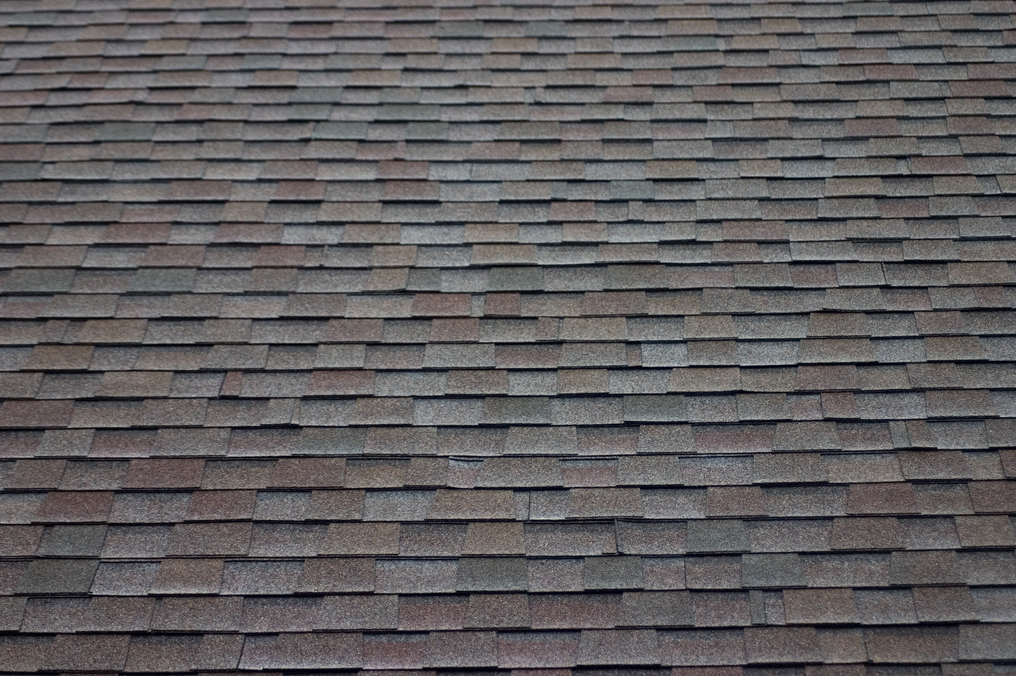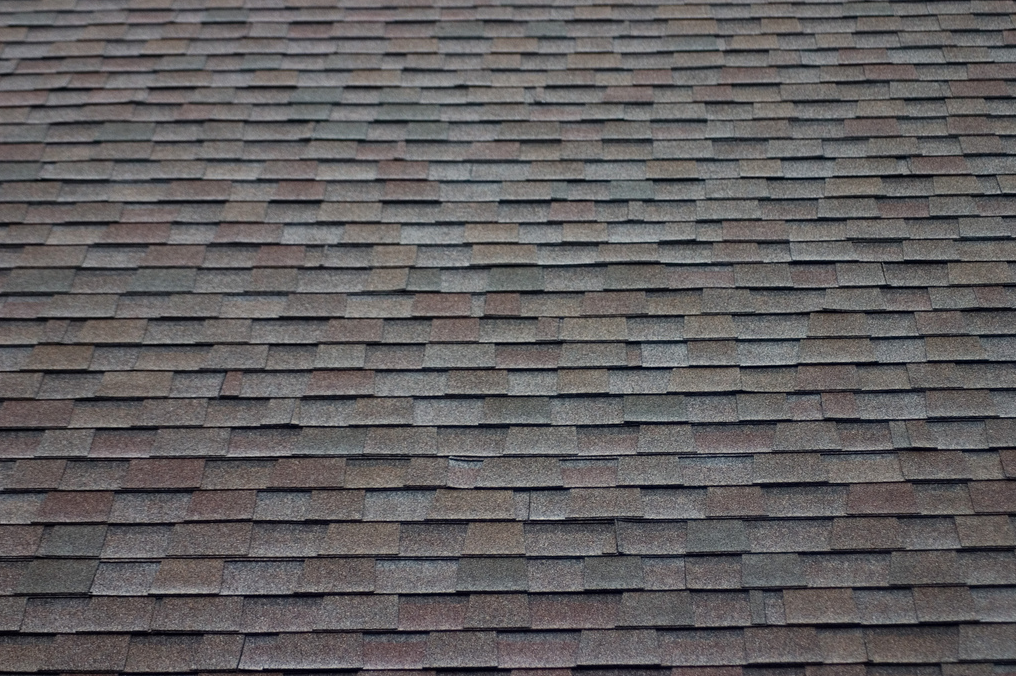Types of Shingles

In the roofing industry there are many different types of shingles. The types of roofing shingles available differs based on size, shape, color, thickness and material. This article has been created to help explain the shingle roof types available for residential roofs.
*Please take advantage of our table of contents bar in the right sidebar. Simply click on the topics to go straight to that specific topic within this "Types of Roofing Shingles" article.
Types of Shingle Material
Asphalt
 Asphalt shingles are one of the most widely used roofing materials on the market today. Asphalt shingles are used on residential shingle roofs or also referred to as steep slope roofs. The asphalt shingle has advanced since its creation to its current day types, styles, shapes, colors, and sizes. The reason we call them asphalt shingles is because they are primarily composed of asphalt.
Asphalt shingles are one of the most widely used roofing materials on the market today. Asphalt shingles are used on residential shingle roofs or also referred to as steep slope roofs. The asphalt shingle has advanced since its creation to its current day types, styles, shapes, colors, and sizes. The reason we call them asphalt shingles is because they are primarily composed of asphalt.
List of Asphalt Shingle Benefits:
2. Although they cost less there life expectancy ranges from 20 years – 50 years which most home owners find satisfactory when compared to the cost savings in the material itself.
3. Asphalt shingles are also one of the easiest roofing materials to install and are often installed by eager DIYers/home owners.
4. With the modern advancements in technology and design asphalt shingles are made in many different colors and designs. Some asphalt shingles are designed to replicate the look of wood shake, tile, and other types of more expensive roofing materials. This range of looks is one of the most important aspects that a homeowner looks at when deciding on a roof material. They want to know that it will look good on their roof.
List of Asphalt Shingle Faults:
- Asphalt shingles do not do particularly well in climates that change drastically. Asphalt shingles do well in conditions that are always warm or even always cold but if the temperature is prone to change quickly, then the shingles are more prone to crack, break, or wear away. Thus, if your home is located in a climate of quick changing temperatures, it may be in your best interest to spend more on your roof by going with more expensive roofing materials.
- Although asphalt shingles have come along way in technological advancements they still are one of the weakest roofing materials. They can easily be damaged by hail storms, high winds, and other natural causes. Because of this, it is highly probable that an asphalt shingle roof will either need to be repaired or completely replaced before the lifetime of the roof has been reached because of natural damage.
- Asphalt shingles are only installed on steep slope roofs. Because of this asphalt roofing shingles cannot be used on flat roofs or low slope roofs.
Are They Eco Friendly?
Many green minded people/home owners want to know if the roof they are installing is environmentally safe. If you are one of these types of home owners, then you will be happy to know that when it comes time to remove your asphalt shingles they can be recycled.
Fiberglass Shingles
Historically the mat of the shingles was made from a wood and paper felt material. Today a more advanced mat is created from fiberglass. Fiberglass is a type of material that is used for various things. In this case it is used to create shingles. It is created with plastic backed by fine fibers of glass. For shingles, fiberglass provides reliable strength and durability.
The fiberglass in asphalt/fiberglass shingles creates the mat portion of the shingle. The fiberglass that creates this shingle mat is compiled by randomly laying wet fiberglass and then bonding it with urea-formaldehyde resin. After this is done the mat goes through a process of coating. It is coated with asphalt but not just any asphalt. The asphalt is mixed with various types of mineral fillers. These mineral fillers give the shingle and mat waterproof characteristics which is a very important aspect shingles provide as a roofing material.
One of the benefits of a fiberglass shingle roof is that it is more fire resident. A fiberglass shingle usually has a class A fire rating. Compared to the older wood and paper mats used for asphalt shingles, the fiberglass shingles are much better for your home, especially when it comes to fire residence.
Organic Shingles
Companies stopped manufacturing “Organic Shingles” around 2005.
The decline in popularity and production was caused by their inability to last longer than fiberglass shingles. Many various lawsuits have been filed by homeowners against shingle manufacturing companies that produced and sold organic shingles.
Organic asphalt shingles are a thing of the past. In fact, organic is simply the modern name for the traditional felt mat asphalt shingles. Companies simply took advantage of the eco friendly movement and started calling their felt asphalt mat shingles organic.
How Organic Shingles Were Made?
*This is a simplified explanation of how organic shingles are made…were made.
First, the main product that distinguishes organic shingles vs fiberglass shingles is the “organic” components. The “organic” components of these types of shingles were paper, recycled cardboard, rags, and wood chips. Once these “organic” components were manufactured into a mat they were then saturated with asphalt. In fact, organic shingles contained more asphalt than fiberglass shingles. After the asphalt has been applied, the granules are embedded into the top of the mat giving it protection against the UV rays of the sun.
Wood & Shake
If you ever wonder where we got asphalt shingles from, all you have to do is look at wood shingles. Wood shingles and shakes were here long before the advent of asphalt shingles and are in fact the forefather of the asphalt shingle. Wood shingles are modernly made out of wood or some type of synthetic material. Both the wood shake and wood shingle come primarily from pine, redwood trees, red cedar, and cypress.
Wood Shakes vs Wood Shingles
The difference between shakes and shingles are how they are made. Basically a wood shingle is sawn with uniform ends, tapered evenly and they have a smooth front and back (or similar/identical surfaces); a shake is split but can be sawn, they are more thick at the base end (a.k.a butt end), and are tapered from one end to the other.
Benefits of Wood Shingles:
- With a little maintenance and TLC a wood shingle roof can actually outlast cheaper roof types which can turn the higher cost of wood shake into a cost savings benefit. A good wood roof that is not exposed to too harsh of weather conditions should last up to 30 years.
- Wood shingles are undeniably unique in their appearance. The unique look of wood is one of its most desired benefits.
- Wood shingles are organic and eco friendly. This is an important benefit for those that are looking to be environmentally friendly when choosing what type of roof material they should get installed on their roof.
- Wood shingles are much more energy efficient than asphalt shingles. This energy efficiency could save the homeowner money on their heating and a/c bills.
- Wood shingles are very durable. Unlike other materials they are not prone to crack from hail or by being punctured. They also can withstand high winds much better than asphalt shingles.
Negatives of Wood Shingles:
- Wood shingles or shakes cost more in material and in installation costs. This can be a drawback to many homeowners.
- Wood shingles catch on fire much easier than other types of roofing material.
- Wood shingles are harder to install. The DIYer is much less likely to attempt or even succeed at installing wood shingles.
- Wood shingles take more to maintain. Wood shingles definitely do not fall under the “do it and forget about it” category. To make sure a wood shingle roof lasts it takes some TLC.
- Wood shingles are susceptible to termite damage or other insect problems. They can also suffer from rotting and mold more easily.
Slate
Slate is one of the longest lasting roof materials available. There are slate roofs that are over 100 years old and they are still performing fantastically on the roof top. Slate is a natural rock that is mined and cut to become slate shingles or a.k.a slate tiles.
Benefits of Slate Shingles
- Slate shingles generally last 80 – 100 years.
- Slate shingles are unique in appearance.
- Slate does an amazing job at resisting water absorption. Because it has an extremely low water absorption index (.4%) it does really well in freezing temperatures.
- Slate is strong and isn’t as easy to damage in wind storms or hail storms as compared to asphalt shingles.
Negatives of Slate Shinges
- The initial slate shingle price is much higher than cheaper roofing materials, such as, asphalt shingles.
- If a slate roof does need repaired, it isn’t as easy to find a professional slater to do the job and it will cost more than other roofing repairs.
- Slate roofs are heavy and are not recommended for some structures that cannot support the weight.
Solar Shingles
Join Our Facebook Roofing Group
Hey everybody,
We are going social and have created a new Facebook group for people who want to know more about roofs, roofing problems, fixes, ask pros, etc. Feel free to join. It is a private group so once we get your request to join we will approve it as quickly as possible.
→ Join Here: Roofpedia Facebook Group!
Resources
Great website sharing a lot of information about slate: slateroofcentral.com
Learn the basics of slate itself: en.wikipedia.org/wiki/Slate
A good page talking about the pros and cons of shingle roofing: bigfishroofing.com
Learn how to maintain your shake roof: Oregon State
Learn about organic shingles: nachi.org





